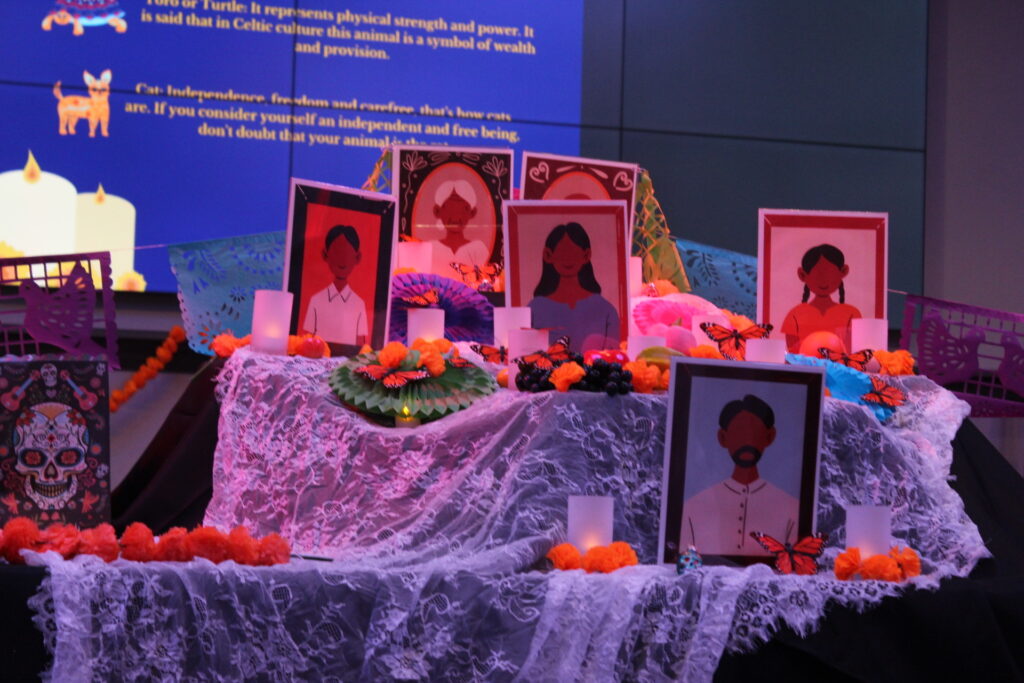Nevaeh Brown
The Latin Cultural Society and the Center for Student Involvement and Inclusion at the University of West Georgia celebrated Día De Los Muertos, observing the holiday on Nov. 1.
Originating from Mexico and celebrated throughout Central America, the holiday is normally celebrated on Nov. 1 and Nov. 2, historically combining the Aztec tradition of celebrating the goddess Mictecacihuatl and influence from the catholic church.
In essence, the first two days are believed to open up a pathway between the spirit world and the real world so deceased relatives and even pets can visit their loved ones once more.
Decorated in Orange Mexican Marigolds, known as ‘the flower of the dead,’ faux tea light candles, colorful skull art and papel picado, which are strung up papers in bold colors like confetti.
This holiday is known for its vibrant color palette despite its death motifs. Black symbolizing the land of the dead and pre-Hispanic religions. Purple signifying pain, suffering, grief and mourning. Pink on the other hand, lends itself to the celebratory spirit of the holiday symbolizing joy in celebrating those who have passed on. White, generally symbolizing purity and renewal for those they have celebrated and honored. Yellow and orange symbolizes the light and the sun via representation in marigold flowers and petals. Lastly, red represents the blood of the life of those honored, honoring them on what’s called an oferenda or an altar, with pictures of beloved family members and pets.
There were smaller, simpler variations of traditional desserts such as sopapilla, which is fried pastry dusted with cinnamon and sugar, the ever popular flan and the Mexican-inspired hot chocolate which was perfect for the chilly day.
On the savory side, there was a Taqueria Migueleño food truck, that served tacos and tamales.
There were several creative activities inspired by traditional customs of the holiday with decorating a cookie shaped like a human skull, which are used to symbolize the departed whose name would be written on the skull’s forehead to honor the deceased spirit.
There were also alebrijes, which are small wood sculptures that visitors could color with pastel colored paint markers. Traditionally, alebrijes are shaped like dogs representing loyalty and protection. Others are shaped like axolotls, a type of salamander, representing new beginnings with several other animals.
“They represent an energy or a characteristic of yourself,” said volunteer and member of the Latin Cultural Society Ana Pacheco-Baez.
A mariachi trio played music as part of the celebration that filled the exterior of the Campus Center Ballroom. There were also two caricature artists that the participants enjoyed with family and friends.
“It’s a holiday plenty of my friends celebrate. I got to learn some new things and I definitely could have used the break from schoolwork,” said senior Ijore Trice.
It was a perfect way for students to unwind with friends as final projects and assignments for the semester approach this month.
You may also like
-
Ingram Library Works to Find Balance Between Physical and Digital Resources in a World so Dependent on Technology
-
UWG Welcomes Alum Brian Nunez as Keynote Speaker for 41st Annual MAP Awards
-
UWG’s Student Activities Council Hosts the Spring Festival of Colors, Celebrating Culture and Community
-
Georgia Power Donates $25,000 to UWG’s Student- Run PR Firm, bluestone
-
Le Mépris and the Horizons UWG French Film Festival: Living West
